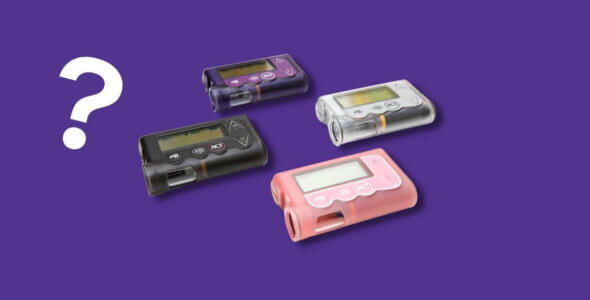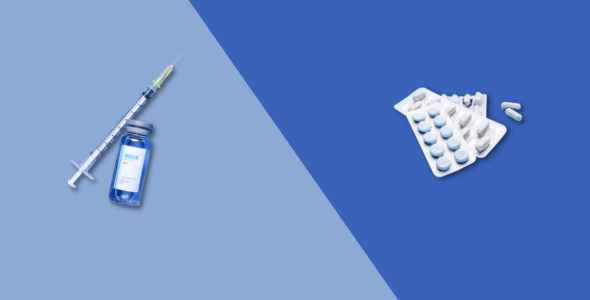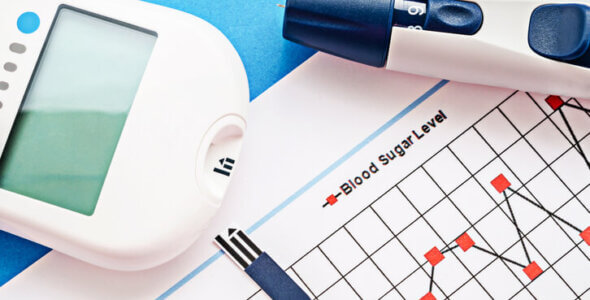What is insulin resistance?
Table of contents
- Understanding insulin
- What causes insulin resistance?
- How does insulin resistance develop?
- Risk factors for insulin resistance
- Insulin resistance symptoms
- Complications of insulin resistance
- How is insulin resistance diagnosed?
- Can you prevent insulin resistance?
- Can you reverse insulin resistance?
- Treating insulin resistance
Insulin is a hormone that helps your body to transport glucose sugar from your blood into your cells. Insulin resistance is a condition where insulin stops working as well, meaning your cells do not absorb as much glucose as they should. Insulin resistance can lead to health problems like high blood glucose levels and type 2 diabetes.
The condition is common in the US, with between 26% and 32% of adults having some degree of insulin resistance. This number is rising too, and more and more children are also developing insulin resistance.
Here we explain everything you need to know about insulin resistance, including what causes it and how you can reverse insulin resistance.
Understanding insulin
Insulin is a hormone made by your pancreas, a small organ found behind your stomach. It has a range of functions in your body, but the two most important are to do with maintaining a healthy blood glucose level.
When you eat or drink, glucose sugar is released into your blood as you digest. Your blood then takes it around your body, delivering it to the cells that use it for energy. Insulin in your blood helps your cells absorb this glucose. Insulin molecules attach to the surface of your cells which triggers them to bring glucose transporting proteins to the surface. This then draws glucose into the cell.
If you have more glucose in your blood than your cells need, insulin also signals your liver to absorb and store the excess glucose. It can then be used later when your blood glucose has fallen.
If your cells become insulin resistant:
- They absorb less glucose from your blood than they should
- Your liver stops storing as much insulin as it should
What causes insulin resistance?
Insulin resistance causes cells in your muscles, fat, and liver to stop responding as well to insulin. It is not fully understood why this happens, but it is known that the following are associated with it and thought to be insulin resistance causes:
- High levels of fat in your blood
- Inflammation in your body
- A high intake of fructose sugar (from foods that have added fructose sugar like candy, soda, sweetened yogurt, bread, and juice)
- Being physically inactive
How does insulin resistance develop?
Unless insulin resistance is addressed, it usually worsens over time. As your cells become more resistant to insulin, the amount of glucose in your blood rises and your pancreas releases more insulin to deal with it.
But as insulin resistance continues to worsen, your pancreas must make higher levels of insulin to maintain a healthy blood glucose level. However, your pancreas can become stressed and a point is reached where it stops making more insulin. After this point, your blood glucose continues to rise and reaches a level that begins to harm your body. This can cause prediabetes. And as your blood sugar rises further you can develop type 2 diabetes (or gestational diabetes in pregnant women).
Insulin resistance is at the heart of diabetes and is the leading cause of prediabetes, gestational diabetes, and type 2 diabetes.
Risk factors for insulin resistance
A range of factors increases your risk of developing insulin resistance. Some risk factors are out of your control, but many you can control and you can take actions to address them.
Insulin resistance risk factors out of your control:
- Genetics (your genes can make you more likely to develop insulin resistance, but do not guarantee it)
- Age – being over 45 years old
- A family history of prediabetes or type 2 diabetes
- Obstructive sleep apnea
- Polycystic ovary syndrome
- A hormonal disorder, like Cushing’s syndrome or acromegaly
- African American, Hispanic, Native American, Asian American, or Pacific Islander ancestry
Insulin resistance risk factors you can control:
- Being overweight or obese
- A large waist size and fat stored around your stomach
- High bad cholesterol (LDL) and low good cholesterol (HDL) levels
- High blood pressure
- Being physically inactive – not taking regular physical exercise and spending large parts of the day sitting still
- Eating a diet rich in sugar, refined carbohydrates, saturated fat, processed foods, and junk food
- Smoking tobacco
- High levels of stress for prolonged periods
Insulin resistance symptoms
One of the biggest problems with insulin resistance is that you may not know you have the condition without having a blood test. Insulin resistance initially causes no noticeable symptoms. In fact, the CDC estimates around 84% of US adults who have insulin resistance have not realized it.
Signs of insulin resistance only become noticeable once you have passed the point at which your pancreas is no longer producing enough insulin and you begin to develop prediabetes or type 2 diabetes. Early symptoms of diabetes include:
- Feeling tired
- Feeling hungrier and thirstier than usual
- Peeing more often than usual
Read more about the early signs of diabetes.
Complications of insulin resistance
If insulin resistance is left untreated, it can lead to:
- Extremely low blood glucose levels if your pancreas releases too much insulin (hypoglycemia)
- High blood glucose levels as your pancreas no longer produces enough insulin (hyperglycemia)
- Prediabetes
- Type 2 diabetes
- Heart attacks
- Strokes
- Kidney disease
- Eye problems that can lead to vision loss and blindness
- Nerve damage
- Cancer
- Alzheimer’s disease
How is insulin resistance diagnosed?
Insulin resistance is primarily diagnosed by using blood tests. Your doctor or another healthcare professional will take a sample of your blood, then use one or more of the following tests to find out how your body is handling glucose:
- Fasting plasma glucose test: This test measures how much glucose you have in your blood after you have not eaten for at least 8 hours. This shows if your baseline blood glucose is in the normal range or too high.
- Oral glucose tolerance test: First you take the fasting glucose test above, then you drink a sugary solution, and 2 hours later your blood is drawn again. This shows how your body copes with an influx of glucose and whether your blood glucose level remains elevated.
- Hemoglobin A1c test: This test measures your average blood glucose levels over the past 2 to 3 months and shows if your blood glucose has been too high over this period.
In addition to the above tests, a doctor will also ask you questions about your lifestyle, what you eat and drink, how much exercise you get, and your medical history as well as that of your family. They may also give you a physical exam (like taking your blood pressure and weight) and/or measure your cholesterol and triglyceride levels when they take your blood.
Can you prevent insulin resistance?
There are steps you can take to prevent your chances of developing insulin resistance. If you tick several risk factors for insulin resistance or have any other reason to think you are at risk of developing it, you can do the following:
- Maintain a healthy weight – your BMI should be between 18.5 to 24.9 (talk to your doctor about how best to lose excess weight).
- Exercise regularly – read more about regular exercise.
- Eat a healthy diet – choose a diet rich in fresh fruit, vegetables, whole grains, pulses, legumes, nuts, lean meat, and fish. Reduce your intake of sugar, refined carbohydrates, saturated fat, salt, processed food, and junk food.
- Quit smoking.
- Reduce your stress levels – try to address causes of stress in your life and do not feel guilty about taking time to relax and enjoy yourself each week.
If you are worried you are at risk of insulin resistance, you should arrange to have regular blood tests with your doctor to stay on top of your blood glucose, cholesterol, and triglyceride levels.
Can you reverse insulin resistance?
The best news about insulin resistance is that it can be reversed. Making lifestyle changes can help improve insulin sensitivity and completely reverse the condition. Try:
- Losing excess weight
- Adopting a regular exercise routine
- Reducing how much sugar, refined carbohydrates, saturated fat, salt, processed, and junk food you eat
- Eating more fresh fruit and vegetables, whole grains, pulses and legumes, nuts, lean meat, and fish
- Quitting smoking
- Reducing your stress levels
- Making sure you get enough sleep each night
If you have another medical condition that makes insulin resistance more likely such as sleep apnea, polycystic ovary syndrome, or a hormone disorder, treating your disorder can help reduce insulin resistance.
Type 2 diabetes medications can be used if you have developed type 2 diabetes. These medications may also be suitable insulin resistance treatments during earlier stages of the condition. These include:
Treating insulin resistance
Insulin resistance is a common condition. It is also one you should be aware of as it can lead to type 2 diabetes and a range of other health complications. Although insulin resistance is serious, it can be reversed through making lifestyle changes.
If you already have diabetes, lifestyle changes can also help to lower your insulin resistance and can help you manage your condition. Lifestyle changes are just one part of living with diabetes. Diabetes medications are also important in treating it.
If you have been prescribed diabetes medication, you may be able to receive your prescription for $49 per month with NiceRx. Complete our online enrollment application to find out if you are eligible for prescription assistance.
Medically reviewed
A medical professional has reviewed this article.

Jamie Winn, PharmD
Jamie Winn, PharmD
Dr. Jamie Winn received his Doctor of Pharmacy in 2002 from the University of South Carolina College of Pharmacy, Columbia, SC. Jamie is a medical reviewer for NiceRx.

